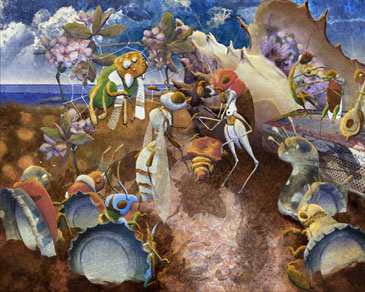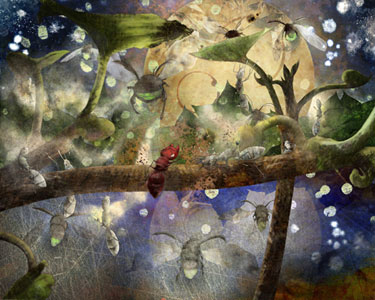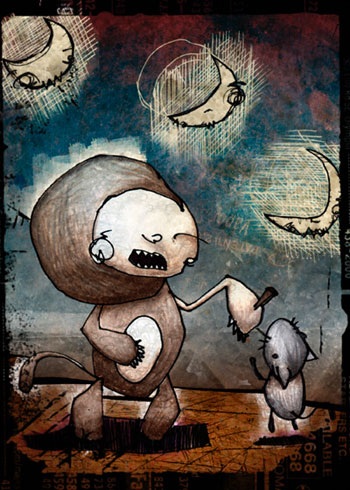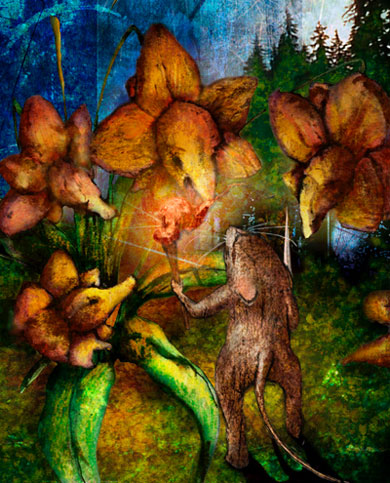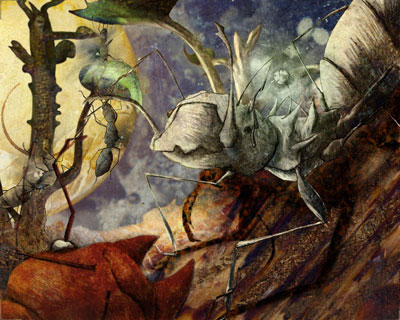|
||||||||||||||
|
S
e p t e m b e r 2 0 0 5
|
||||||||||||||

Sketch Pad
Ryan Swanson Manifest imagination by Kathy Anderson
Swatch this
"I generally start with pencil line drawings," he said. "I scan them into my computer and arrange them into rough storyboards using Photoshop. In this early composition each pencil drawing is a different layer so it's easy to move things around. "I color in the shapes with the textures I collect using a flatbed scanner. With this technique, an ant drawn is suddenly filled in by red lacquer or a swatch of pebbly, corroded sheet metal." Ryan prints the images as black-and-white laser copies and tapes them down to a light table. Using tracing paper, he draws other objects into the work, then adds volume and shading to figures already in place, mostly with colored pencils. "All of these tracing sheets have calibration marks so that I can scan them back into Photoshop and align them over the original drawing," he said. "I repeat this process of printing and re-editing the piece until a life-like quality emerges. "I now have a shadowy web of colored graphite drawings suspended over the original line drawing." The layered look
"Reading the white values out of my shading layers I create highlights by stenciling in bright textures. It feels like oil painting and produces a visual quality that many people, artists included, mistake for watercolor," he said. On separate layers behind the foreground Ryan develops the background of the piece with digital textures using a Wacom tablet. "I save the sky for last because it's my favorite. I generally construct clouds and celestial flotsam from my favorite shapes that I lift off blackened corroded surfaces, such as well-seasoned cookware or the marks left in a ceramic dish after roasting beets with rosemary," he said. "I also like there to be a certain Cubist-like break in perspective that makes you sort of float in and over the picture plane as your gaze moves around." A benefit to working digitally is the ability to change the alpha channel stencils throughout the process. Ryan can cut away textures or use the drawing tablet to re-reveal elements he previously obscured. "Last time I took a traditional drawing class my left hand kept twitching and I realized it was a reflex to hitting Ctrl-Z (the computer's "undo" function). I get spoiled by the ability to go off on a creative tangent and then hop back if I don't like it," he said. "Experimentation becomes more carefree." Ryan uses Photoshop 7, which allows the user to organize and divide layers into folders, allowing him to make far more complex works. "The average The Ant and the Moon piece contains hundreds of layers of textures, alpha channels and pieces of drawings that are multiple gigabytes in size," he said.
Inspiration comes from the textures Ryan works with. When he scans one into Photoshop the first thing he does is adjust the levels, making the lightest parts absolute white and the darkest absolute black. This skews the color palette, bringing out over-saturated colors and letting shapes rise out in high contrast. A lot of the textures come from his kitchen, such as a greasy, blackened cookie sheet he scans every month or so. "I use these shapes to construct the backgrounds in my images or as organic shadows beneath drawn figures," he said."The tree branches in The Ant and the Moon are from some wax paper that had turkey-bacon grease burned on it. It was one of my favorite textures." A big inspiration for The Ant and the Moon series was a group house in North Portland where a filmmaker friend of Ryan's lived. The homeowner was constantly repairing and refurbishing the house. Furnace ducts sprouted from the walls at random and every few feet the floor fell away to a new surface. "All the walls had window frames ripped out or in various stages of installation, so you could really see the texture of the house on an almost anatomical level," he said. "The house had a life of its own and was the inspiration for the ant nest, or formicary." Influences include the actions of the U.S. government and decline of the environment. Ryan feels like he has an obligation as an artist to reveal things that aren't obvious and to make them visible in new ways. "The Ant and the Moon nibbled at this, and the two projects I have in the pipe ask how humanity will continue after a widespread global collapse."
Making book "It's nice to look at the images on a computer – computer monitors literally glow – but I'm eager to have a heavy, well-printed book you can hold in your hands," he said. "The images I make have a lot of detail. It would be nice to screw your face down into a tangible book to appreciate it." Ryan is starting another project, with Jason Maxfield, writer of The Ant and the Moon, which should be finished in April or May 2006. "It's about terraforming an alien planet to house humans and it starts with the destruction of the Earth," he said. "The terraformed landscape is Martian in character but populated with layers of photographed and scanned exotic houseplants. We've been talking about this project since before we even started the ant piece and I'm rabid to sink my teeth into it." An online project is also in the works – a series of fictional blogs he's illustrating with images pulled from his journals. One deals with an astronaut adrift in space who transmits Western serenades back to earth. They'll be available on his Web site. Ryan maintains the site as a sort of elephant burial ground for his work. "I feel like it's where I lay my pieces to rest. The interface is mostly geared around my own ability to access the work when needed." Blending modes
"When I first approached digital media I was just layering photos and textures on top of each other and it was getting heavier and darker and looked terrible," he said. "McKean's work really illustrates the opposite; they're very luminous. I can look at his work and recognize his use of the Photoshop blending modes and how things are constructed, and that's very informative for me. I can appreciate the work he does." Yuri Norstein, a Russian animator, made Ryan think about the way transparent-feeling light could be emulated by layering opaque objects. "Animation has always stuck me as very clever," he said. "Norstein's work has a highly textural feel that really captivates me. In 'Hedgehog in the Mist,' he creates things like fog or tree bark that melt away before the camera." Common allergies "He became a professional community member and an early adopter of desktop publishing to churn out PTA newsletters," Ryan said. "I used his copy of PageMaker to lay out a single issue of a 'zine named Bad Juju, which was called 'pedestrian' by the late meta-zine Factsheet5. It was my first public criticism and it got me really excited, even though it was pretty negative and dismissive." Ryan attended a magnet high school for science and technology in northern Virginia, which had only one art teacher for 1,600 kids. "The teacher was really eccentric with all sorts of allergies to a lot of common art mediums and he regularly told us the ventilation was inadequate, so the only classes available were photography and pencil drawing," he said. Ryan's mother landed him his first job as a Little League photographer. With a Volvo trunk full of equipment, he drove all over northern Virginia and photographed thousands of children. "That repetition affected how I construct and frame my work," he said. "On some level my pictures are the same form repeated over and over, painted in different textures."
Drawing closer "I worked a lot around the idea of subjective media and the power of representation. It was very sobering and a little depressing as I read a lot of work by Zinn and Marx," he said. In his second year Ryan had a more open student contract and collaborated with several other students who were also tired of documentary film. At the end of the year they had a huge body of work, which was colorful and complicated but completely devoid of any meaning. In addition, the computer files were so large that manipulating them was nightmarish and Ryan was backing them up onto a tape drive. "This proved to be a faulty means indeed and I lost all of the digital video I had produced. It was the first of many catastrophic losses and it made me reevaluate what was feasible and obtainable on a home PC," he said. "Though I'm using a DVD burner now, my faith in digital archiving has never been restored." Fueled by a summer of animation classes and a desire to improve his drawing skills, Ryan made a transition from film and video to studio art. One class had a digital component and required students to make a Photoshop image. It was the first time in years that Ryan had used Photoshop to make still images and a floodgate opened. The project spawned a whole series called An Inner Cartography, which can be found on his Web site in the gallery archive. "I did traditional print work and studio drawings, and found new ways to integrate these works into digital pieces, which I printed and hand bound as a series of books," he said. "The images were produced by digitally altering monotype prints I was making in my studio classes and finding ways to keep the texture of charcoal and paper without things feeling overly digital. It was also completely within my computer's capacity and I could finally work without the constant crashing and rebooting and reinstalling, which was the everyday of editing video on my PC." Evergreen is different than other state schools in that it lacks grades or majors. Students are able to tailor their education and walk away with a bachelor of liberal arts or science. "Though I don't have a major, I generally tell people that I focused on digital media having studied documentary and animation techniques," he said. "And I graduated with four credits of Poekoelan Kung Fu." Fully confirmed "To make my imagination manifest is really magical and I love the challenge," he said.
"I had a dream recently where I was walking in the sand and all around me there were these little silver sparrows made of mercury swimming and diving in and out of the sand at my feet. "I remember thinking in the dream how beautiful the textures were in the way they shifted against each other. "I'm now building my Photoshop images with the idea that I will animate them with Flash or AfterEffects. That will be a real milestone." Creating his art often makes Ryan feel like Mickey Mouse bringing the brooms to life in "Fantasia." "There are times when I'm working and the piece literally takes on a life of its own," he said. "I just start giggling and scribbling in the blue textures. I love it. It's a moment of transcendence and it fully confirms what I do." |
||||||||||||||
|
E-mail Ryan at ryan@collectedcrust.com and visit his Web site. You can reach Kathy at kanderson138@comcast.net, and draw on other Sketch Pads. |
||||||||||||||
|
|
||||||||||||||
|
|



